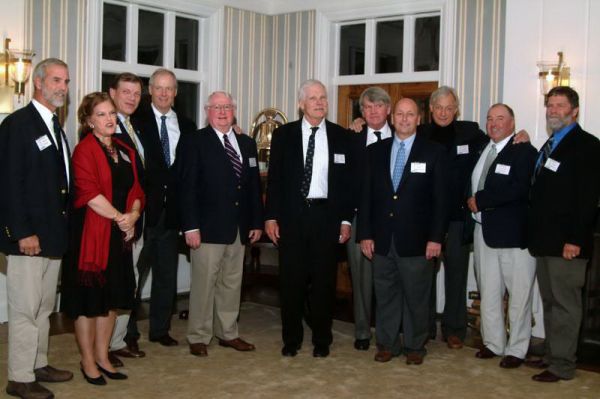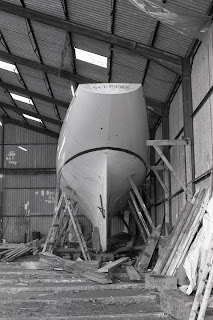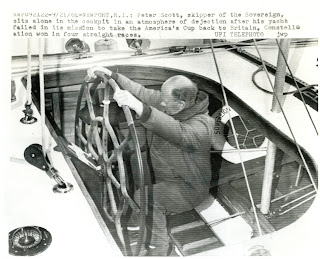Now that I have a go pro and another waterproof video camera. I am always impressed with the video that others are able to shoot and edit. The emphasis being on edit. I am still struggling with this aspect; but enjoying video more every day.
Category: admiral’s cup
FASTNET RACE NEXT
I have sailed 5 Fastnet races, each of which was unique. This race is wonderful because there are so many obstacles many in the form of tide gates such as Portland Bill.
LOOKING BACK AT OCEAN RACING
The Admiral’s Cup, started in 1957 lasting until the 90’s, always one of my favorite events; which in my era included the Fastnet Race.
Recently, the Storm Trysail Club honored Ted Turner and the crew of “Tenacious”; winners of the infamous 1979 Fastnet Race.

These events along with the SORC epitomized ocean racing during a certain period of time that remains under recognized.
Carina and the NYYC Cup 1969
This is a story that was brought back to memory by the thought that Ted Turner has chartered “American Eagle” for the 12 meter re-union in a few days.
In 1969 racing on “Carina” in Cowes (Carina was part of the American Admiral’s Cup Team) We were racing a non-Admiral’s Cup race the Nab tower race. We did very well; not first, but well placed. We were ahead of “American Eagle” most of the course.
The following morning motoring out to the start of a race that did count for the team, a launch from the Royal yacht Squadron came along side with a message for Dick Nye. It was an invitation to the Castle to receive the New York Yacht Club Cup, awarded to the first NYYC boat to finish. Now, we had done well, however another NYYC boat had finished ahead of us. Dick hastily penned a note indicating such and handed it ti the launch.
We had to prepare for our race and anyone who has ever sailed a Cowes week knows it is chaotic with so many boats milling about on or near the starting line. The launch comes along side again with the message “you will attend” Here I must explain that Dick Nye and “Carina” were not only legend in English waters but adored. They simply preferred to award the trophy to Dick and not to the other skipper. Dick went and was awarded the trophy.
 |
| American Eagle behind Carina |
 |
| Crusade at the Nab |
 |
| Royal Yacht Squadron |
12 meter racing before 1958
http://www.britishpathe.com/record.php?id=1079
Leading up to the 12 meter era reunion, this should amuse those who sailed competitively on 12 meters
random events in the world.
|
whale tale  This one is almost hard to believe, and in fact it sort of is… We had been taking some pictures and had just decided to head back when a Southern Right whale, between 11 – 14 m long, breached about 100 meters away from us. It then suddenly breached about 10 meters from us and then – right on us! We were sailing so had no engine and we could not even take any action. Scary!” Read on and see the resultant picture. Thanks to the Portfolio Travel Blog. Jump in the discusion. 07/20/10 |
America’s Cup 1975
1975 was an active year for me. After the America’s Cup we moved to Cowes, on the Isle of Wight where I worked at Souter’s building boats. I continued to sail, skippering the prototype of the Swan 41, named “GunFleet of Hamble” in the Admiral’s Cup Trials. Then the Transatlantic race from Newport to Cowes on “Weald” a Swan 48. Cowes week on “Gitana VI” a new S&S 66′ for Baron Rothschild. The Fastnet on “Guia” a Bob Miller 44′ formerly known as “Gingko”
 |
| duke of york |
 |
| Guia leaving the the fastnet |
 |
| gunfleet of hamble |
 |
| gitana vi |
 |
| wsl and my mother in law at the hamble |
During Cowes week where most everyone was there. I was invited to a meeting with Bob Miller, Johan Valentine, Alan Bond, Warren Jones, and a few others. Ironically, Bob Miller had taken the apartment over the Duke of York where Bernadette and I had lived for more than a year. This meeting was a proposal for me to go to Australia to build the next challenger for the America’s Cup. Naturally lots of questions and answers. The final moment was when Alan Bond asked if I would bring the lines of “Courageous” which I had built. When I answered “NO” the meeting was over.
America’s Cup 1964
With each new challenge the design race increased. “Constellation” the newest Sparkman&Stephens design was only second best entering the August trails. “American Eagle” the Bill Luders design and build, was up 21 and zero, appearing unbeatable and in the difficult position of not having lost a race; not knowing what if anything to change.
Eric Ridder stepped aside as skipper of “Connie”being replaced by Bob Bavier. Along with a few other changes and she went on to be selected to defend. Leaving Bill Cox the skipper of “American Eagle” stunned.
The American trials were the highlight of the summer, the English challenger “Sovereign” was hopelessly outclassed.
Olin Stephens, I believed, liked to make small incremental changes, As the season of 1967 would show; “Constellation” exhibited some of the genes that would become “Intrepid”.
The energy and enthusiasm ratcheted up with each challenge. The world was emerging from World War II, coupled with that was the easing of Taxes on the rich. America was truly on top of the world; and feeling that way.
There are more stories connected with the summer of 1964 and this challenge deserves more time.
Sceptre, K 17 the British challenge 1958
 Sceptre, sail number k 17, was the Royal Yacht Squadron’s challenger, built in Scotland, designed by David Boyd. launched in April 0f 1958.
Sceptre, sail number k 17, was the Royal Yacht Squadron’s challenger, built in Scotland, designed by David Boyd. launched in April 0f 1958.









